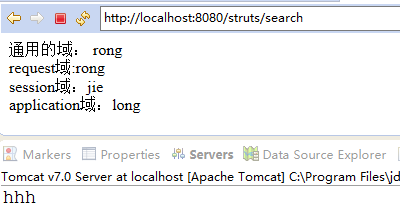Struts2(三)
以下内容是基于导入struts2-2.3.32.jar包来讲的
1.全局视图配置
xml标签:
<global-results> <result name="error">/error.jsp</result> </global-results>
1 package com.ronng.web.action;
2
3 public class TwoAction {
4 public String show(){
5 return "error";
6 }
7
8 public String look(){
9 return "error";
10 }
11 }
<?xml version="1.0" encoding="UTF-8" ?>
<!DOCTYPE struts PUBLIC
"-//Apache Software Foundation//DTD Struts Configuration 2.3//EN"
"http://struts.apache.org/dtds/struts-2.3.dtd">
<struts>
<package name="com.rong.web.action" namespace="/" extends="struts-default">
<!-- 全局视图。当action标签里面不包含result标签时,就会寻找全局的global-results结果视图 -->
<global-results>
<result name="error">/error.jsp</result>
</global-results>
<action name="error1" class="com.ronng.web.action.TwoAction" method="show">
</action>
<action name="error2" class="com.ronng.web.action.TwoAction" method="look">
</action>
</package>
</struts>
访问路径:
http://localhost:8080/struts/error1
http://localhost:8080/struts/error2
返回的都是同一个error.jsp页面
2.全局的异常配置
1 package com.ronng.web.action; 2 3 public class TwoAction { 4 public String show() throws Exception{ 5 //抛出异常,无法返回"error"字符串 6 int number=1/0; 7 return "error"; 8 } 9 10 public String look()throws Exception{ 11 return "error"; 12 } 13 }
struts.xml配置是有顺序的:全局结果视图需要放在全局异常的前面

<?xml version="1.0" encoding="UTF-8" ?>
<!DOCTYPE struts PUBLIC
"-//Apache Software Foundation//DTD Struts Configuration 2.3//EN"
"http://struts.apache.org/dtds/struts-2.3.dtd">
<struts>
<package name="com.rong.web.action" namespace="/" extends="struts-default">
<!-- 全局视图。当action标签里面不包含result标签时,就会寻找全局的global-results结果视图 -->
<global-results>
<result name="error">/error.jsp</result>
<result name="exception">/exception.jsp</result>
</global-results>
<!-- 全局异常配置 。result对应全局视图的result的name-->
<global-exception-mappings>
<exception-mapping result="exception" exception="java.lang.Exception"></exception-mapping>
</global-exception-mappings>
<action name="error1" class="com.ronng.web.action.TwoAction" method="show">
</action>
<action name="error2" class="com.ronng.web.action.TwoAction" method="look">
</action>
</package>
</struts>
以上的方法不能处理类似404的错误,若要处理404错误,则只需要修改web.xml配置文件
<error-page>标签配置
<?xml version="1.0" encoding="UTF-8"?>
<web-app xmlns:xsi="http://www.w3.org/2001/XMLSchema-instance" xmlns="http://java.sun.com/xml/ns/javaee" xsi:schemaLocation="http://java.sun.com/xml/ns/javaee http://java.sun.com/xml/ns/javaee/web-app_3_0.xsd" id="WebApp_ID" version="3.0">
<display-name>struts</display-name>
<welcome-file-list>
<welcome-file>index.html</welcome-file>
<welcome-file>index.htm</welcome-file>
<welcome-file>index.jsp</welcome-file>
<welcome-file>default.html</welcome-file>
<welcome-file>default.htm</welcome-file>
<welcome-file>default.jsp</welcome-file>
</welcome-file-list>
<filter>
<filter-name>struts2</filter-name>
<filter-class>org.apache.struts2.dispatcher.ng.filter.StrutsPrepareAndExecuteFilter</filter-class>
</filter>
<filter-mapping>
<filter-name>struts2</filter-name>
<url-pattern>/*</url-pattern>
</filter-mapping>
<error-page>
<error-code>404</error-code>
<location>/404.jsp</location>
</error-page>
</web-app>
3.最简单的action配置
<?xml version="1.0" encoding="UTF-8" ?>
<!DOCTYPE struts PUBLIC
"-//Apache Software Foundation//DTD Struts Configuration 2.3//EN"
"http://struts.apache.org/dtds/struts-2.3.dtd">
<struts>
<package name="com.rong.web.action" namespace="/" extends="struts-default">
<!-- 最简单的action
class 默认是struts-default.xml的
<default-class-ref class="com.opensymphony.xwork2.ActionSupport" />
默认执行的method 是 execute
方法默认的返回值是什么 "success"
-->
<!-- 对于最简单的action也就是
没有配置class的action要执行的哪个action,
可以不使用默认的,重新配置 ,但是依然会使用默认的 execute方法-->
<default-class-ref class="com.ronng.web.action.OneAction"></default-class-ref>
<action name="simple">
<result>/index.jsp</result>
</action>
</package>
</struts>
4.路径访问搜索顺序
<?xml version="1.0" encoding="UTF-8" ?>
<!DOCTYPE struts PUBLIC
"-//Apache Software Foundation//DTD Struts Configuration 2.3//EN"
"http://struts.apache.org/dtds/struts-2.3.dtd">
<struts>
<!--
资源路径
http://localhost:8080/struts/search
http://localhost:8080/struts/aa/bb/cc/search
以上两种方式均可访问到同一页面
其中http://localhost:8080/struts是服务器以及项目信息
主要看这段:/aa/bb/cc/search
搜索顺序:没找到时继续往前找,由于search是action里面的name路径,所以最后才判断
先判断package,最后才判断action
namespace是/aa/bb/cc
namespace是/aa/bb
namespace是/aa
namespace是/
有这个/的命名空间了
那就在这个命名空间的action里找search
-->
<!-- namespace命名空间不写时,默认是斜杠"/" -->
<package name="com.rong.web.action" namespace="/" extends="struts-default">
<action name="search" class="com.ronng.web.action.OneAction">
<result>/index.jsp</result>
</action>
</package>
</struts>
5.获取域对象以及ActionContext上下文
A.第一种方式(通过ServletActionContext获取)
1 package com.ronng.web.action;
2
3 import javax.servlet.ServletContext;
4 import javax.servlet.http.HttpServletRequest;
5 import javax.servlet.http.HttpSession;
6 import javax.servlet.jsp.PageContext;
7
8 import org.apache.struts2.ServletActionContext;
9
10 /**
11 * 普通类获取域对象
12 * 通过ServletActionContext获取
13 * @author Rong
14 *
15 */
16 public class TwoAction {
17 public String show() throws Exception{
18 //使用原生API,耦合度高,很少使用
19 PageContext pageContext = ServletActionContext.getPageContext();
20 //可通过pageContext获取其余域对象
21 // ServletRequest request = pageContext.getRequest();
22 // HttpSession session = pageContext.getSession();
23 // ServletContext application = pageContext.getServletContext();
24 HttpServletRequest request = ServletActionContext.getRequest();
25 //获取前台传过来的值
26 String parameter = request.getParameter("name");
27 System.out.println(parameter);
28 HttpSession session = request.getSession();
29 ServletContext application = ServletActionContext.getServletContext();
30 request.setAttribute("name", "rong");
31 session.setAttribute("name", "jie");
32 application.setAttribute("name", "long");
33 return "success";
34 }
35 }
<body>
通用的域: ${name }<br/>
request域:${requestScope.name }<br/>
session域:${sessionScope.name }<br/>
application域:${applicationScope.name }<br/>
</body>
<?xml version="1.0" encoding="UTF-8" ?> <!DOCTYPE struts PUBLIC "-//Apache Software Foundation//DTD Struts Configuration 2.3//EN" "http://struts.apache.org/dtds/struts-2.3.dtd"> <struts> <package name="com.rong.web.action" namespace="/" extends="struts-default"> <action name="search" class="com.ronng.web.action.TwoAction" method="show"> <result>/two.jsp</result> </action> </package> </struts>

B.第二种方式(ActionContext上下文的get方式)
1 package com.ronng.web.action; 2 3 import org.apache.struts2.dispatcher.ApplicationMap; 4 import org.apache.struts2.dispatcher.RequestMap; 5 import org.apache.struts2.dispatcher.SessionMap; 6 7 import com.opensymphony.xwork2.ActionContext; 8 9 /** 10 * 普通类获取域对象 11 * 通过ActionContext上下文get方式获取 12 * 松耦合 13 * @author Rong 14 */ 15 public class TwoAction { 16 public String show() throws Exception{ 17 //获取ActionContext上下文。ActionContext在请求最开始的时候封装了所有数据。 18 ActionContext actionContext = ActionContext.getContext(); 19 //通过get方法获取域对象。其中get里面的字符串是唯一指定的。 20 RequestMap requestMap = (RequestMap) actionContext.get("request"); 21 SessionMap<String, Object> sessionMap = (SessionMap<String, Object>) actionContext.get("session"); 22 ApplicationMap applicationMap = (ApplicationMap) actionContext.get("application"); 23 requestMap.put("name", "rong"); 24 sessionMap.put("name", "jie"); 25 applicationMap.put("name", "long"); 26 return "success"; 27 } 28 }
C.第三种方式(ActionContext上下文的getXxx方式)
1 package com.ronng.web.action;
2
3 import java.util.Map;
4
5 import com.opensymphony.xwork2.ActionContext;
6
7 /**
8 * 普通类获取域对象
9 * 通过ActionContext上下文getXxx方式获取
10 * 松耦合
11 * @author Rong
12 */
13 public class TwoAction {
14 public String show() throws Exception{
15 //获取ActionContext上下文。ActionContext在请求最开始的时候封装了所有数据。
16 ActionContext actionContext = ActionContext.getContext();
17 Map<String, Object> request = actionContext.getContextMap();
18 Map<String, Object> session = actionContext.getSession();
19 Map<String, Object> application = actionContext.getApplication();
20 request.put("name", "rong");
21 session.put("name", "jie");
22 application.put("name", "long");
23 return "success";
24 }
25 }
D.第四种方式(实现XxxAware接口)
根据需要实现不同域的接口
1 package com.ronng.web.action;
2
3 import java.util.Map;
4
5 import org.apache.struts2.interceptor.ApplicationAware;
6 import org.apache.struts2.interceptor.RequestAware;
7 import org.apache.struts2.interceptor.SessionAware;
8
9
10 /**
11 * 实现接口方式获取域对象
12 * 松耦合
13 * @author Rong
14 * 这里列举了实现多种域接口,实际根据自己需要实现接口
15 */
16 public class TwoAction implements RequestAware,SessionAware,ApplicationAware{
17 //需要自己去声明成员变量(域对象)
18 private Map<String, Object> request;
19 private Map<String, Object> session;
20 private Map<String, Object> applicaton;
21 public String show() throws Exception{
22 request.put("name", "r");
23 session.put("name", "j");
24 applicaton.put("name", "l");
25 return "success";
26 }
27 //域对象赋值
28 @Override
29 public void setApplication(Map<String, Object> arg0) {
30 this.applicaton=arg0;
31 }
32
33 @Override
34 public void setSession(Map<String, Object> arg0) {
35 this.session=arg0;
36 }
37
38 @Override
39 public void setRequest(Map<String, Object> arg0) {
40 this.request=arg0;
41 }
42 }



